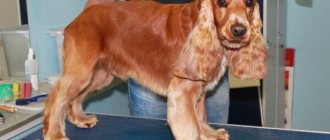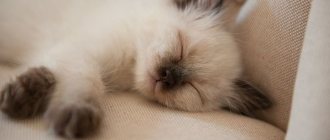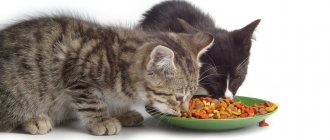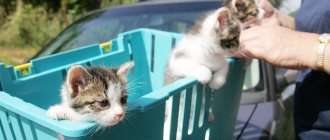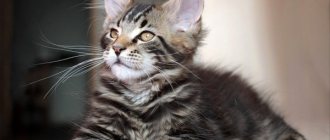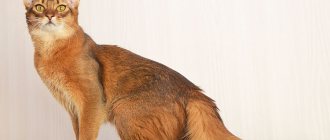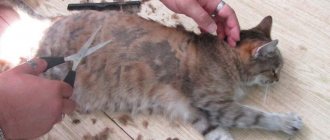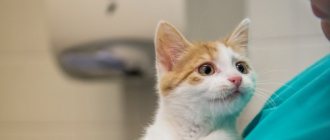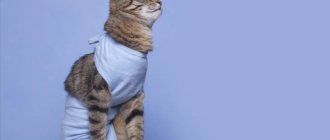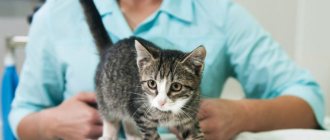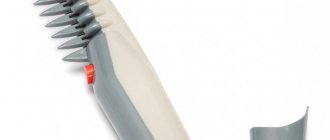Psychological readiness
To participate in an exhibition, an animal must be mentally prepared; those with a docile, peaceful character perform especially well - aggression at exhibitions is unacceptable and leads to disqualification. The cat must be adapted:
- to loud sounds;
- various smells;
- a large number of people;
- constant attention;
- in the wrong hands.
To do this, owners of more than one generation of cats always take 3-4 month old kittens with them to exhibitions. Yes, these kids are not participating, but they are already getting used to the exhibition rhythm.
What to do if the cat has not been trained since childhood? Then, 3-6 months before the exhibition, regular psychological training begins, including:
- going outside in a carrier;
- travel by car;
- stay in an exhibition and portable cage;
- gatherings with strangers.
To train, people unfamiliar to the cat (but not the owner!) should calmly pick up the animal, carefully examine it, and then return it to the cage. You can take your cat to visit your family and friends. It’s good if the cat has the opportunity to play and communicate with cats or dogs - in this case, he is calmer about the presence of other animals.
Adaptation will be faster if the cat makes friends with the exhibition cage ahead of time. To do this, toys and bedding are placed in the cage, trying to interest the pet.
Some veterinarians and cattery owners advise giving the cat sedatives 2-3 days before the exhibition, but in this case the owner must be careful with the dosage so that the cat does not become lethargic and apathetic at the event.
How can I find out about the location of the exhibition?
In this regard, owners of domuses (this is what felinologists call cats without a pedigree) are very lucky. Unlike owners of purebred cats, they don’t have to bother with choosing a judging system, an expert, a felinological organization and other issues that are quite difficult for a layman to understand. All you need to do is find out the schedule of exhibitions, which can be done at your local felinological club or on the Internet. Then you need to call the organizers of the exhibition and ask whether applications from participants are accepted for the “domestic cat” class. A class is a group of cats that are similar in one way or another, so the exhibition will include classes such as kittens, breeders, purebred castrati and others.
Sometimes local clubs organize exhibitions dedicated only to outbred cats, which attract a fairly large number of participants and spectators. But, unfortunately, such events have recently become much more rare.
Physical Compliance
Any preparation for a cat show makes sense if the animal has no physical defects and meets breed standards. Each breed has its own beauty parameters.
Health
The health of your pet is of great importance; for this, on the eve of exhibition events, you should conduct a veterinary examination and obtain a certificate:
- form 1 - for an exhibition in another city;
- Form 4 - for an event in your city.
A cat that the owner intends to demonstrate at an exhibition must be treated for fleas and helminths, which is noted in the veterinary passport.
There must also be a record of vaccinations:
- against rabies;
- chlamydia;
- leukemia;
- panleukopenia;
- rhinotracheitis;
- calicivirus.
Preparing for a cat show includes taking medications to relieve sexual arousal.
Nutrition
To ensure that the animal looks healthy, but not fat, and has a shiny coat, special attention is paid to nutrition a month before the exhibition.
2-3 weeks before the exhibition, the pet can be switched to food with a high protein content or to special food for pregnant cats or kittens. You should first make sure that the new food will not cause allergies in the animal.
If the pet has gained excess weight, it is transferred to a fasting diet 5-6 weeks before the event.
Although premium food contains a vitamin supplement, to improve appearance 3-4 weeks before the exhibition you can additionally introduce the following into the diet:
- seaweed - in some cases it brightens the color and color of the eyes;
- biotin and B vitamins - stimulate hair growth;
- carrots enhance the red color.
Important! 3-4 weeks before the exhibition, the cat should be encouraged to exercise.
First time at the exhibition: tips for beginners
This article describes general information on how to prepare not only British cats, but also cats of other breeds for an exhibition. It's no secret that at many Russian exhibitions poorly prepared, shedding, overfed and even unhealthy animals are presented. And it is very disappointing when a representative of such animals demonstrates them as an excellent breed type.
It seems that their owners paid $1,000 for the kitten and now believe that for that price the animal should prepare itself for the exhibition event.
But seriously, there is very little literature that gives competent advice for preparing a cat for an exhibition. Many periodicals have published materials on the training of only Persian cats, which is why owners of other cat breeds begin to think that they can take their pets to an exhibition at any time.
Many owners, deprived of information, follow illiterate advice or use the described preparation of Persian wool on their animal of another breed - many experts are faced with powdered Angoras and combed Siberians!
In addition, local felinological organizations do not inform owners that poor preparation for the exhibition can lead to deprivation of the title or cause a lack of nomination in Best in Show. And in the end, they begin to make claims to the experts and ask that during the examination they give priority to the type of animal, regardless of behavior, tearing and quality of fur. The texture of the coat refers to the same full-fledged breed characteristic as the type of animal, and you can “earn” about 5-10 points on it. If the wool is improperly prepared, it is impossible to determine its quality, which means that the animal is deprived of its 10 points, and the title accordingly.
By and large, each breeding center or club should provide consultation to its members on the issue of both the daily care of the animal and the issue of exhibition preparation of any breed that is available in this organization. Whether such consultations are paid or free depends on the club, but they must conduct them without fail. Also, clubs should have contacts of permanently practicing grooming specialists, and if the owner of the animal does not have the opportunity or simply does not want to prepare the cat for the exhibition himself, then he should have the opportunity to use the services of a groomer.
Physiological condition, health and conditioning.
The health of an animal presented for exhibition must be confirmed:
1. Documents from the veterinary clinic about vaccinations performed (certificate, veterinary passport)
2. External examination by a veterinarian, which is carried out before registration of the participant on the day of the exhibition.
Vaccination.
When holding an exhibition, Russian sanitary and epidemiological authorities usually require proof of rabies vaccinations. The exhibition organizers have every right to request proof of vaccination against many other diseases (microsporia, panleukopenia, etc.), as well as a veterinary certificate that the animal does not have internal parasites.
A veterinarian who examines animals at an exhibition is required to record the absence of fleas, ticks and other external parasites, as well as other external signs of disease, for example, fungus, lacrimation, nasal discharge, etc.
However, chronic diseases that are in remission cannot be identified during such an examination. Remember that it is in your interests to present a healthy animal at an exhibition, because... an exhibition is stressful for animals and it is likely that this stressful situation can provoke an exacerbation of diseases.
Consequence of injuries.
Before the exhibition, you need to make every effort to protect your pet from injuries such as abrasions, scratches, bites that the animal may receive during mating or fighting.
An animal that shows obvious signs of minor injuries risks losing 5 points. And if there are significant injuries, the animal may be disqualified altogether. If there are serious injuries that have left a mark on the appearance of the animal - a broken tail, wounded ears, eyes - this will not affect the animal’s breeding career in any way, but will be an obstacle to its exhibition career.
If you are a member of a felinological organization in which, in order for an animal to participate in breeding work, it must receive a breeding assessment at an exhibition, know: such an assessment is usually obtained at an exhibition held at the level of your club. The organizing committee and the heads of the club's breeding commission may require you to provide a medical report on the origin of your pet's traumatic defects.
Often, the show condition of cats can be disrupted by increased activity of the sebaceous glands, which are located at the root of the tail, as well as inflammation of their ducts. To prevent this, it is necessary to monitor the condition of the skin in the area of the cat’s tail; if it becomes dirty, thoroughly rinse the area where the ducts are located.
In cases where signs of inflammation appear, you should contact a veterinary clinic. Excessive activity of the sebaceous glands may be a sign of metabolic disorders. Be sure to go for a consultation with a veterinarian - perhaps it’s a matter of housing conditions, breeding load and feeding that will need to be changed.
Pregnancy.
An expert can evaluate a pregnant cat until the pregnancy becomes visible externally (up to approximately 4 weeks). You should not forget about this if you have plans for a cat’s breeding and exhibition career.
Lactation.
A nursing cat can also undergo the examination, however, when signs of lactation are visible externally (absence or darkening of hair in the nipple area, enlarged mammary glands), the expert deprives the animal of five points from the overall score. That is why there is no point in putting a nursing animal on a title higher than CACIV.
Estrus is not an obstacle to participation in the exhibition. You just need to take into account that a cat in this physiological state is often nervous and excited.
If the pet is aggressive, it is recommended to take permission from members of the exhibition committee to independently show your animal without the help of stewards.
You should also remember that the smell of a cat in heat excites cats, which is why you should not place the animal in a show cage next to such a neighborhood.
Shedding.
Shedding is a natural periodic state of an animal and is seasonal in nature. When cats are kept in an apartment with central heating, the intensity and frequency of shedding is disrupted, and sometimes it is very difficult to predict what form the animal will be in by the time of the exhibition.
You should try to note all the features of your pets' shedding - the timing of shedding, the rate of change of shedding areas and the growth of new fur. You should monitor the sequence of changes in different types of hair - undercoat, guard, outer coat, and also at what stage of molting the animal loses its decorative hair.
This knowledge gives an idea of whether the animal will be in show shape by the required date. The order of changing hair types deserves special attention, because... the texture of the coat as a whole greatly depends on their ratio.
Cats usually shed unevenly. The greatest degree of shedding is observed in breeds that have a developed undercoat - British, Persians, exotics, etc. With the seasonal loss of undercoat, not only the appearance of the animal deteriorates, but also the typical texture of the coat is distorted - due to the fact that the coat is dominated by outer and guard hairs, it appears harsh, dry or coarser. The loss of outer hair and distortion of the coat texture is typical for those breeds that have thick, water-repellent outer hair, for example, Siberians. The fur of these animals often becomes softer during molting due to the absence of outer hair.
You should also know that molting can worsen the color. You should try to determine the extent to which your cat's color changes during shedding. Solid color (with the exception of white) during the molting period loses uniformity of tone, smoky color - a clear contrast, and often the “smoke” itself due to the loss of undercoat in different parts of the body.
This also applies to chinchillas, shaded and cameo, their color becomes darker, the tipping loses uniformity, and it also happens that a shadow pattern begins to appear on the body and legs.
During seasonal molting, the color of a tabby may lose its clear pattern. In general, you can see that the consequences of shedding often affect smoky colors, chinchillas and cameos, i.e. colors that are characterized by white, contrasting and golden undercoat. The loss of the undercoat of such animals is really a big nuisance, which can lead to a decrease in the score due to a color defect, as well as to the fact that the external color of the cat will not correspond to the real one and stated in the evaluation sheet.
Prolonged and excessively intense shedding is a clear indicator of health problems. There can be many reasons - lack of vitamins, dysbacteriosis, liver disease, hormonal disorders, etc. Contact your veterinarian and do all the necessary tests before you start feeding your pet vitamin supplements.
Fatness.
Strictly speaking, cats of all breeds have the same nutritional requirements. Fat deposition in certain areas of the body, muscle mass and bone strength are hereditary and create the specific appearance of the breed. An animal that is in show condition should not have visible ribs; they should only be palpable. This also applies to the vertebrae of the back. When turning the body, the ribs can be slightly visible only in hairless and short-haired breeds of light build, for example, in Siamese, Oriental, and St. Petersburg Sphynxes.
For cats of any breed, belly fat is extremely undesirable, with the exception of the Ragdoll breed. However, these fat deposits are considered the least of the faults in heavily built breeds (British, Sacred Burmese, Siberian) than in lighter built breeds (Angora, Russian Blue, Norwegian Forest).
It is better to prevent deviations in the animal’s fatness than to urgently correct the situation a month before the exhibition. Many owners overfeed their pets. And if you sharply reduce the amount of food 1-2 weeks before the exhibition, the animal will certainly lose weight, but it will not be possible to get rid of the stretched skin that forms in place of fat deposits during this period.
It will take about a month and a half to restore skin elasticity. In addition, it is worth considering that animals lose weight unevenly, just like people. If you start feeding your animal less, it may well be that the cheeks will lose weight, but the fat in the abdominal area will remain in its place. This often happens in British and Siberian cats.
There is also the opposite picture, which is typical for the eastern group of breeds - deposits on the belly disappear so much that the body shape required by the standard is violated (tubular), but the massiveness and cheeks remain unchanged. And most importantly, a sudden “diet” leads to metabolic disruption and contributes to the development of dysbiosis.
The process of reducing body condition must begin no later than a month and a half before the exhibition. Did you realize it later? – take measures, but it is not recommended to force this process. Even if the animal earns a lower score at the next show, it will remain healthy and will be able to undergo high-quality training for the next shows.
The amount of feed should be reduced gradually, and the reduced portion of the portion should be replaced with vegetables or steamed bran. If the animal eats dry food, it can be replaced with low-calorie food. These foods are suitable for animals that do not have indications for feeding specialized foods for the prevention and treatment of urolithiasis, hypoallergenic, etc.
There is no need to switch the animal to “unfamiliar” food two weeks before the exhibition, even if it is of high quality, no one is immune from an individual allergic reaction. It is very important to increase the animal’s exercise, especially when kept in small apartments and small enclosures.
Lack of nutritional status is often associated with nutritional imbalances, elevated levels of sex hormones (especially in young animals) or health problems. If there is insufficient nutrition, analyze the animal’s diet to see how complete the food is. You can try changing the diet, as well as making the feeding scheme optimal. When feeding dry food, it is worth using one that will promote weight gain.
If, after changing your diet, no improvement is observed, you should consult with a veterinarian, do tests for the presence of dysbiosis (one of the most common causes of weight loss), helminthiasis, and also to determine the level of digestive enzymes. If the cause of insufficient nutrition is the animal’s high sexual activity, then it is worth considering whether it should be exhibited right now or at the moment it is better to use the pet as a breeding animal.
Animal behavior at an exhibition and its resistance to stress.
It is necessary to prepare an animal for an exhibition from its very birth - this is a completely fair thesis regarding the behavior of a cat. The exhibition environment is unfamiliar territory for the animal; “strange” cats are very stressful, especially if the pet is not used to trusting people and quickly adapting to a new environment.
Trust in people and easy contact with them begins to form in infancy. It is recommended to periodically pick up small, suckling kittens, so that the animal gets used to humans (reaction to handling). Young animals that grew up in conditions of minimal interaction with people (for example, in a nursery, in an open-air cage) often become fearful and unsociable.
The aggression of a cat at an exhibition is most often associated with fear (unfamiliar people, place); less often, aggression is provoked by the smells of unfamiliar individuals (more typical for cats). Aggression, which is caused by the second reason, is practically impossible to correct, unlike a defensive reaction.
To prevent an unfamiliar environment from becoming a serious shock for the animal, it is recommended to gradually accustom it to a change of environment (walk with the animal, go on a visit with it, take it out into nature). The sooner an animal begins to participate in exhibitions, the easier it will be for him to adapt to them.
Participation in exhibitions at an early age forms the correct behavior of the cat in the hands of the owner or steward during the exhibition. It should be noted that the position of the animal during such a display varies depending on the breed, so it is worth finding out in advance the display option for your pet.
Many people show cats holding them in a free position in their arms - the front legs are held with one hand, the hind legs are supported with the other. Owners of breeds with a dense short body (exotic, Persian, British) - in a somewhat grouped (collected) position.
Bobtails are held in the arms in a slightly curved position so that the expert or spectator can simultaneously see both the tail and the head of the animal (or at least in profile). For a high-quality display, it will be enough if the cat behaves “well” in the arms not only of its owner, but also of people unfamiliar to it.
The most specific display is the demonstration of the eastern group of cats - Balinese, Oriental, Siamese, etc. When showing these cats, they need to be stretched so that others can estimate the length of their body.
Stretching display has 2 options:
1. Stretch “on the hand” - the body of the animal is located on an outstretched arm, its front paws are held with the fingers of the same hand, the hind limbs are supported with the second hand. This display is considered the most difficult, but it gives the animal the opportunity to show not only the length of its body, but also the shape of the back of its head and the length of its neck.
2. Free stretching “sagging” - the cat is held under the front and hind limbs, while the body sags freely. In this version, you can also show cats of other breeds with a characteristically long body (St. Petersburg Sphynx, Macoon). Bengals are shown in the same way so that those present can appreciate the animal’s patterned color to the maximum.
In order for animals to feel free, and not try to escape or shrink into a ball during a complex display, they need to be taught this from an early age. For Oriental and Siamese cat breeds, you can use any of the stretching options described above, so you should understand in advance which method they prefer.
To reduce stress reactions to the maximum and increase adaptation to the exhibition environment, you can use special medications - usually immunostimulants (immunofan, SGOL - homogenized serum enriched with lactates). Do not try to overcome an animal's stress with tranquilizers, diphenhydramine and other medications intended for humans. Animals often experience a paradoxical reaction to such drugs, i.e. the cat begins to become even more excited, breathing becomes disrupted, and profuse salivation begins. Plus, it is extremely difficult to calculate a safe dose of this type of drug.
General rules of exhibition grooming.
After finishing show grooming, the cat must demonstrate:
- clean coat and skin without signs of dandruff;
- clean inner surface of the ears;
- clean eyes and the area around them without mucous and tear secretions and their traces (brown or yellow spots on the fur);
- clean area around the anus.
To comply with these rules, the cat must be washed - partially or completely - before the exhibition. It is worth noting that it is not at all necessary to wash short-haired and semi-long-haired cats before each exhibition, but only if the “problem” areas (discussed below) and the fur are not dirty.
The most common mistakes of inexperienced owners:
- washing the cat on the day of the exhibition;
- washing the cat with a product intended for humans;
- washing the cat with a low-quality product for animals.
As a result of such mistakes, the breed-specific texture of the coat is disrupted, dandruff and an allergic reaction appear. Therefore, to care for an animal’s fur, you need to use only specific products intended for cats. Ring 5 shampoos, products and Jean Pierre Hari, etc. have proven themselves well. Many shampoos of any consistency (dry, liquid) are specialized for colors and breeds. But do not forget that any shampoo, even from the most famous manufacturer, can provoke an allergic individual reaction in an animal. Therefore, you should not use unfamiliar means before an exhibition without first checking. Wash certain parts of the animal’s body with new shampoo at least a month before the exhibition, evaluate the quality of the washed fur, make sure there is no irritation, dandruff or allergic reactions.
The use of various products and the timing of washing are individual and directly depend on the color and breed of the animal. When grooming, you should pay special attention to the place where the ducts of the sebaceous glands are located - the outer surface of the tail root.
Other problem areas, especially in silver and white cats, are the insides of the paws and lower legs, the areas around the mouth and under the eyes. To clean “problem” areas on the tail and legs, you can use the same products as when washing a cat. Some owners use dishwashing detergents to whiten these areas.
The use of such products is allowed, the main thing is to choose ones that are pH neutral and do not irritate the skin. To get rid of deposits of tear stone, yellow spots on fur, and fat, there are special cosmetic bleaches (“8 in 1”, “Iraise Ring 5”). But it is best to prevent such stains from appearing, because... when removing them, there is a possibility that the product will get into the eyes, and this may cause conjunctivitis.
A healthy animal's ears are usually clean, but earwax can sometimes accumulate in them. Wax is removed with a cotton swab without the use of boric alcohol, anti-mite drugs and other medications that can irritate the skin of the ear. Wax is usually removed the day before the exhibition, but it is advisable to inspect the animal’s ears in advance - 2 weeks before the exhibition. The appearance of crusts and noticeable black dots in the auricle indicates the presence of inflammatory processes or ear mites, so contact your veterinarian immediately.
Nail trimming is another mandatory requirement in preparation for an exhibition. A “manicure” is given to the animal the day before the exhibition. This operation requires special nail clippers or nail clippers. The use of nail scissors, even well-sharpened ones, is undesirable, because... the claw may crack when trimmed or peel off. Before the procedure, examine the claw: it consists of dead tissue (the transparent tip) and living tissue (the white base with a blood vessel inside). Nail trimming is carried out only in the dead transparent zone so that the blood vessel is not touched. The claw is usually trimmed to about 2-3 mm.
Features in color preparation.
It is recommended to wash animals of dark and intense colors (chocolate, tortoiseshell, black, smoky variations, brown and black tabby) approximately 7-10 days before the exhibition. Animals with lightened and contrasting colors (silver tabbies, cream, blue), as well as dark colorpoints (blue, chocolate, seal) and cameo color - 4-5 days before the exhibition. Light colorpoints, chinchillas, biocolors - 2-3 days before the exhibition. Wash the day before the exhibition, i.e. for the night, you can have British, exotic and Persian cats of white color. Cats of other white breeds – 2-3 days before the exhibition. For these animals, like chinchillas and bicolors, on the day before the exhibition, if necessary, you can additionally wash the yellowing areas on the legs, the root of the tail, etc.
In monochromatic animals, individual white hairs are plucked out, which are found on the back, withers, legs, along the tail; in harlequins and bicolors, individual white hairs are found in colored spots.
Cold-colored cats (blue, black) are not recommended to take sunbathing before the exhibition - the fur may fade and acquire brown and rusty shades. To improve color contrast, Thai Shorthair and Thai cats are dressed in overalls or blankets during the shedding period, and the shedding hair is combed daily. But if this is done with colorpoints of other breeds, the quality of their coat may suffer. You can improve the uniformity of tipping in animals of silver shaded color and chinchillas by plucking the dyed to the base or the darkest coarse outer hairs, if there are not too many of them, of course, and also provided that the cat is not molting.
On store shelves there is a huge assortment of products for caring for the fur of animals of almost any color - conditioners, tinted shampoos, products that even out the color tone, for raising the coat, lightening or intensifying the color. Before making your choice, consult with the seller which option is right for your animal. It is not advisable to purchase new products immediately before an exhibition, but if you still really want to, then you need to test its effect in advance on a separate area of the animal’s body.
Accessories for the exhibition.
1. Inside the decorated cage there must be bedding and a curtain that will cover the cage on 3 sides. The curtains serve not only as a background, but also thanks to them the animal is less nervous about the proximity of “strange” cats. If the exhibition allows you to use your own cages, then the side opaque walls of the exhibition box can be used for the same purpose.
2. Disinfectants, which can be used to treat cells, hands, and napkins for disinfection.
3. Rubber mitten (brush), metal comb, massage comb with rounded teeth - a set depending on the breed of cat.
4. Cosmetics (powder, means to eliminate traces of lacrimation if necessary) for long-haired cats.
5. Cotton swabs (preferably sterile) or paper napkins for cleaning eyes.
6. Eye drops for long-haired cats that are prone to watery and sore eyes.
7. Tray.
8. Paper or gauze napkins.
9. Drinking water and water bowl for cats.
Also, do not forget to take with you the cat’s pedigree (or a copy of it), championship certificates (a copy of the certificate is possible), veterinary passport or veterinary certificates, paid receipt for the examination, club membership card (if available).
Exhibition ethics.
Registration for the exhibition.
You must accurately indicate the details of your animal on the application form. If by the day of the exhibition there were changes in the exhibition class, a transfer to a different color and other changes were made, then it is necessary to notify the members of the exhibition committee about this, ask for changes to be made to the evaluation sheets before the start of the examination.
When submitting an application to participate in an exhibition of a club other than that of which you are a member, you should find out in advance in which organizations the declared experts were licensed and which felinological organization registered the exhibition. Find out in your club whether the titles that will be received from these experts and at the exhibition of this organization will be counted in it.
You cannot be late for registration on the day of the exhibition - the exhibition committee has every right not to allow your animal to be examined.
Do not forget that examination by a veterinarian when registering participants is a mandatory event. Before accepting an application for participation in the exhibition, the exhibition committee is obliged to warn all interested participants about how much a veterinary examination costs and whether they need to have veterinary certificates or a veterinary passport with notes on vaccination against certain diseases. Many organizing committees, in order to avoid misunderstandings, give those who signed up for the exhibition a memo that lists the requirements for the exhibitor, and take a receipt from the participants stating that they agree to comply with all the listed requirements.
In addition, when submitting an application, check with the organizer whether it is allowed to place animals in the exhibitor’s cages. If this is not allowed or you do not have your own cage, you need to find out the size and design of the cages that will be at the exhibition - knowing such data, you will be able to adjust the design to the desired size.
Behavior at the exhibition.
An exhibition is a celebration, and you should try to dress accordingly. Even if you are exhibiting an animal for the sake of sporting interest, then it is still not worth coming to an exhibition event in a tracksuit.
In cases where the examination is carried out in an open American or European ring, you should not interfere with the expert’s work - ask questions, comment on his actions, or get too close to his table.
If the examination is carried out without stewards and the owners have to carry their pets themselves to the expert’s table, in this case one should not speak to a member of the examination, unless the initiative comes from his side. Trying to find out an assessment or getting verbal approval for your pet can be regarded as pressure on the expert.
If stewards are present at the examination, but you have reasons to refuse their services (the cat shows aggression towards new people, is overly excited), then you need to ask permission from members of the exhibition committee to show the cat yourself. However, you need to take into account that they have the right to refuse you.
Unacceptable behavior towards members of the exhibition committee, the expert, exhibitors and stewards entails the removal of the participant from the exhibition and the removal of his animal from examination.
Claims to the exhibition.
If any complaints arise against the organizing committee (for example, replacing a previously announced expert), the work of the stewards (for example, a late call for examination), or the exhibition secretariat (data errors in the evaluation sheet), you must contact the members of the exhibition committee or transfer them through the senior steward, your complaints directly at the exhibition. Exhibition committee members are required to take action to correct errors.
In cases where the mistake of the secretary or steward cannot be corrected, because The examination of the competitive group of cats has ended, the exhibition commission is obliged to apologize and return your registration fee. But if an error occurs due to your fault (lateness for the examination, incorrect data on the application form), the exhibition in this case does not bear any responsibility and no one will return the registration fee to you.
If, in your opinion, the exhibition did not satisfy your claims, please contact the disciplinary commission of the organization that registered this exhibition in writing.
Claims to the expert.
The expert's assessment is not discussed or corrected. There is no need to express your complaints personally to the expert or members of the exhibition committee. All they can do to help you is to prove the expert’s competence in assessing certain breeds, because It is the exhibition organizers who can request a license from the expert, which confirms his right to conduct an examination. But if you think that:
— the assessment received by the animal is unfair (for example, the assessment sheet does not contain a justification for deprivation of the title, or the assessment and description do not correspond to breed standards);
— the expert’s behavior towards you or your cat was incorrect,
You can safely file a complaint with the disciplinary commission of the organization where the expert was licensed. The exhibition must provide information about this organization. If you have any complaints related to the evaluation of the animal, be sure to attach a copy of the evaluation sheet.
If after reading the article you still have not changed your mind about exhibiting your animal at various exhibitions, then I wish you high marks and many victories!
3.9 / 5 ( 8 votes)
Preparing the appearance
Grooming is an important element of preparing a cat for an exhibition; it emphasizes the thoroughbred and beauty of the animal.
Taking care of your pet’s appearance begins not a day or two before the event, but from the birth of the kitten. The cat is washed occasionally (or when it is very dirty), but depending on the length of the coat, it is combed 1-2 times a week. Regularly clean the animal's ears and eyes, trim its claws, and remove tartar.
Before the exhibition, all these procedures are mandatory in full; they must demonstrate the merits of the pet in the best possible way.
conclusions
Today we talked about cat shows, and why they are held, what useful things you can learn from this event, how to prepare for it and how to prepare your cat for this important day. We also considered the basic rules of behavior during the exhibition. We hope that following our tips and tricks will help your cat get the reward it deserves.
Does your cat participate in exhibitions? What titles does she have? We are waiting for your comments and invite you to join the discussion of this topic in our VKontakte group...
We are waiting for your feedback and comments, join our VKontakte group!
the washing up
Preparing for a cat show begins with bathing, but first you need to:
- comb with a sparse comb to rid the cover of dead hairs;
- trim claws;
- clean the inside of the ears;
- if the standard allows, pluck the hair on the ears from above;
- Place cotton balls in your ears.
When bathing, the cat should have support under its feet.
Washing takes place in 5 stages:
- Using products for deep cleaning of fur, thoroughly soap the animal. Particular attention is paid to the locations of the glands - behind the ears, under the tail, paws, pants. Light wool is bleached with special means, keeping them on the cover for 3-5 minutes. Rinse thoroughly, adding vinegar (4 tbsp per 10 liters) or citric acid (1 tsp per 1 liter).
- Another soaping with a degreasing shampoo is combined with combing. A wide-toothed metal comb will come in handy. Lather your hair with a sponge or toothbrush. Rinse the animal with plenty of water.
- Lathering with exhibition shampoo, special attention to the face and paws. Rinse.
- Lathering with tinted shampoo, which will add brightness and shine to the coat. Leave for 10-15 minutes and wash off.
- For volume, the wool is treated with conditioner and styling gel. Then you need to rinse the cat thoroughly
Show temperament
Before you think about how to get to a cat show, you should make sure your pet is ready to visit such a crowded place. There is no point in wasting time on grooming and travel if the cat is shy, aggressive and has never left the apartment. The socialization of the future starlet begins from a very early age. An unsociable, shy cat, surrounded by a crowd, a cacophony of alien smells and deafening sounds, will experience extreme stress. How can you participate in a cat show if the contestant hisses, scratches the expert and bristles her fur from fear? Most likely, such a cat will be disqualified or given the lowest score. As a result, money and time are wasted, the cat is stressed, and the owner is upset.
If a pet cannot tolerate the touch of others, does not tolerate a stranger touching its head, looking into its ears and eyes, touching its tail and paws, there is no need to subject its nervous system to such a load. There are online cat shows - a kind of amateur beauty contests for those owners who, for whatever reason, do not want to burden themselves with long trips. Of course, the titles and titles awarded to competitors are not recognized by official feline systems. But because of this fact, an online cat show does not lose its attractiveness for amateurs, because positive emotions do not depend on the presence or absence of a stamped diploma.
Drying
First, the cat must be blotted with a towel, treated with an antistatic agent and dried with a hairdryer, while styling it so that the fur does not get tangled and gets volume.
- Paws. Using a brush, the wool is lifted from the bottom up, drying the base of the coat.
- Collar. The fur must be pulled back with a comb to make it straight and smooth.
- Muzzle.
- Back. Comb against the grain.
- Pants and belly. The wool is pulled down.
Light wool is powdered to avoid contamination, then the excess is blown out with a hairdryer.
It is recommended to drop Visine into the animal's eyes - this will relieve irritation.
Grooming
On the day of the exhibition they do grooming. The goal is to give the coat volume and shine, protect it from electrification and pollution, and make the pet appear in ideal form.
In the morning, the cat is combed against the grain, having previously been treated with an antistatic agent, exhibition foam or powder.
As a result, the animal’s fur should be soft to the touch and fall off gently.
Important! It must be remembered that excessive coloring and the use of powder on the animal will result in disqualification.
After the exhibition, it is necessary to bathe the cat again to wash off all the drugs from it.
Preparing shorthair cats for an exhibition
One of the most common misconceptions among people who decide to get a short-haired purr for the first time is the belief that the shorter the coat, the easier it is to care for. If this rule is somehow suitable for caring for your pet at home, then if you decide to make your Siamese or British dog a star of cat shows, you should forget about the “wash & go” procedure and seriously take care of your pet’s appearance.
Why do we need cat shows?
If we visit a cat show, we will see rows of decorated cages containing cats of various breeds. The exhibition catalog will help us understand this diversity. It contains all the necessary information about all the pets present: name, breed, color, age, breeder, information about parents. In addition, the catalog contains information about the organizing club, experts and other useful information.
An exhibition is not only a display of animals, it is a competition, choosing the best.
Cat industry
For fun, cats began to be adopted into homes relatively recently. The first official cat show took place in 1871 in London, when only 170 cats took part. The star of this exhibition was the Siamese breed. The next exhibition took place only 18 years later. It was only in the twentieth century that the cat products industry was formed, which is rapidly developing from year to year.
No matter how much it pains you to realize, your cat will feel great in a box with cotton bedding and will not appreciate all the delights of an expensive designer house. And if she suddenly feels uncomfortable there, then you can throw away the masterpiece - she will not sleep there under any pretext.
The notorious scratching posts, which are quite expensive, should appeal to your pet, besides you. But if she has made it a habit to sharpen her nails on a door or sofa, you can only cope with it by trimming her nails regularly. This must be done extremely carefully and competently so as not to harm the cat, but in some cases this is the only way to save the furniture.
And preparing a cat for exhibitions can seriously shake the financial situation: shampoos only from a certain manufacturer, combs with some magical properties. And it is impossible to convince the owner that an identical comb ten times cheaper than a “cat’s” one will also work.
The “everything for cats” industry is intensely occupied with the needs of humans, playing with their ambitions, desires and perceptions of the world around them.
How is the cat show going?
Each breed has a standard that determines what the breed's head shape should be, eye shape and color, ear set, body structure, coat length and texture. For each breed there is a list of colors and requirements for them. For example, for tabby-colored cats, a clear and contrasting pattern is important; smoky-colored cats should have a white undercoat.
Experts at the exhibition evaluate cats in accordance with the standard , give them certain points, from which scores and titles are added up. They choose the best representative of the breed, the best representative of the color, etc. Cats of the same breed and color compete for the title.
History and organization of exhibitions
Caring and ambitious owners began presenting their beloved cats at exhibitions 140 years ago. The first cat show took place in 1871 in London. After this, domestic cat lovers began to hold exhibitions of their pets in other countries of the world. In 1895, America's first cat show took place. It was held in New York, and in 1924, cat shows were first organized in Germany and France.
The exhibition is always organized by a club (society) of cat lovers. To participate in the exhibition, you must submit an application and pay a fee. In addition, each animal will need its own cage for presentation. If your pussy does not yet have its own cage, then you need to contact the exhibition organizers.
The organizers of the exhibition can provide your pet with their existing cages for the duration of the show, just agree with them about this in advance. It is best to drape the walls of the cage with curtains, and put a blanket on the bottom of the cage. This is necessary to keep your pet calm and maintain hygiene standards. The color scheme of curtains and blankets will help highlight the color of your animal.
The second and most important point is preparing your pet for the exhibition . A cat entered into the show must be healthy and have high-quality, well-groomed fur. To do this, you need to think about her diet in advance, switch the cat to a nutritious balanced diet, constantly monitor her health and coat condition, and also conduct training in preparation for the exhibition.
Four days before the exhibition, the cat must be washed, and the powder that you use for cats must be thoroughly combed out, wiped over the ears and corners of the animal’s eyes. Take a wool brush, napkins and a garbage bag with you to the exhibition (just in case). The cat you are presenting must be of a calm disposition so that the judges can inspect it carefully.
Pregnant (1 month or more) animals and lactating cats and kittens less than 8 weeks old are not allowed to participate in the exhibition. Cats that have diarrhea, a runny nose, or suffer from scabies, as well as cats with fleas, are not allowed to participate in the exhibition. Under no circumstances should you dye an animal's fur, otherwise the judges will be forced to disqualify your pet. If the animal is not sufficiently prepared for the exhibition, this will always affect the results.
At an exhibition, a cat either takes a prize or it doesn’t. The owner must be prepared for this in advance and, in any case, regardless of the results of the exhibition, he must remain completely calm. It is immoral to take out your dissatisfaction on a cat. She is not to blame for anything and is still worthy of her master’s love!
A cat show is, first of all, an amazing show where we get to know beautiful representatives of various breeds of cats, enjoy communicating with animals, learn and learn a lot of new and useful things about our favorite cats.
Inter-show cat care
It’s worth explaining right away that caring for an animal (this means washing the cat, combing it, cleaning the ears, trimming the claws) is called grooming . Victory at the exhibition is impossible without all of the above manipulations. This applies not only to long- or semi-long-haired animals, but also to short-haired cats.
Grooming is divided into inter-show grooming (grooming during breaks between outings) and directly at show grooming. These types of care differ in the use of fundamentally different drugs. But, one way or another, one jar of shampoo and conditioner is not enough here. Remember that animal fur varies in texture, fullness, density, color, thickness of hair and undercoat, its length, as well as the age of the cat.
The older the animal, the coarser its coat and the more difficult it is to care for it before the exhibition.
All these factors must be taken into account when choosing cosmetics. Although professional grooming products are not cheap, the results are worth it.
Inter-show grooming is, first of all, bathing. The animal's fur is freed from dirt and fat (and at the same time from parasites, worm eggs, fungal spores), and the skin is freed from dead particles of epithelium. Thanks to this, the regeneration of the coat occurs faster after moulting. Particular emphasis should be placed on bathing during periods of shedding to speed up the process of coat renewal. Since the appearance of the cat is not particularly important between exhibitions, simpler shampoos can be used for bathing, but still with natural oils and a light base.
The cat needs to be washed a week before the exhibition, and inter-show grooming involves washing once every 2-3 months. However, frequent washing deprives the cat's fur of protection and leads to the appearance of dandruff, so lubricate your pet's fur with special creams every day.
You need to brush your cat at least once a week. Combs can be chosen according to your discretion and wallet. Combs are not suitable for British Blues - they use massage combs and brushes with natural pig bristles to polish the hair. Slicker brushes are absolutely not suitable - these are exclusively Persian utilities.
Before combing short-haired cats, the fur should be sprayed with lotion.
As a matter of fact, this is all inter-show grooming. These are simple operations, the whole point of which comes down to weekly repetition. However, they significantly save time, and most importantly, nerves before the exhibition, when the wool can only be slightly refined, and not urgently resuscitated.
Secrets of care a week before the competition
When starting to actively prepare for an exhibition, do not expect to use the same means as you would at home. The competition places completely different, high demands on the animal’s condition. Always remember that you do not need to achieve a momentary result at any cost, but take a serious approach to the issue. After all, most exhibitions last two days, and the abundance of powders and gels on the first day will glue the wool together stronger than cement. You need to be especially careful with incompatible drugs - powder and oils, gels and lotions. In breeds where the volume and thickness of the coat are of particular importance, the cleanliness of the coat before the exhibition is of key importance. The cleaner it is, the better it holds volume. Therefore, a week before the competition, wash your pet.
The structure of a cat's fur is such that with prolonged use of oils, it becomes saturated with them and after bathing in regular shampoo it still looks greasy. To prepare for the exhibition, there is a special type of detergent - for deep cleaning. It is used if the cat has thick hair. Immediately after it, you should treat your hair with a structuring shampoo. But if your pet’s fur is a little “liquid,” structuring may squash it a little and the desired effect will be lost. Here, as a supplement, you can use tinting or, conversely, clarifying shampoos. But, again, their effect must be checked in advance. If the coat is hard, you need to use softening shampoos or conditioners.
When to start preparing?
Typically, exhibitions are announced one and a half to two months before the date of their holding; during this period, the pet owner must have time to complete all preparatory procedures. Remember that documents for participation must be submitted at least 2-3 weeks before the opening of the event. Since you have a very large-scale and diverse preparation ahead of you, it is highly advisable to start it soon after the announcement.
It is important to mention that cats aged from three months are allowed to participate in exhibitions, and in the European Union - from 4 months. This is also worth taking into account when assessing timing.
Upon arrival at the place
The first step is to inform the secretariat that you have arrived. To do this you need to register. Take all the documents and get in line. The secretary will check the data and give you the exhibition catalog and two plates with the number. The catalog contains information about the participants and the cat show program. Check all the data: if an error is found, notify the secretary as soon as possible and fill out a special form, otherwise the resulting score will be invalid.
If it is a large international cat show, the boxes provided by the organizers may already be numbered, then all you have to do is find your place. If not, you can choose any table you like. It is advisable that this be a place close to the expert’s table, not in a draft, not under air conditioning. You can remove the cage and set up your own tent. Now it's time to go through veterinary control.
Take with you all the documents, the cat in a carrier and a disposable diaper, which you need to lay on the table before placing the cat on it. The veterinarian will examine your pet and, if everything is in order, will issue you a veterinary certificate. The doctor will not allow an animal to be examined that appears to be unhealthy, an aggressive, deaf or overly timid cat, or a pregnant or lactating pet. In addition, cats with the phalanges of their toes (claws) removed are not allowed for examination.
Now you can settle in. Place the cat in the tent, attach one of the plates with a number to the box (the second is attached to the owner’s chest), pour the cat a drink, and decorate the box. Do not go far from the tent: when the examination begins, the steward will call you personally or your number will be announced over the speakerphone.
Requirements for the appearance of a cat
Requirements vary depending on the breed, but there are a number of general provisions that apply to all or almost all breeds:
- condition – the physical form of the cat must be excellent, the same applies to health;
- correspondence of parameters – the physical parameters of the “competitor” must correspond to the characteristics of the declared breed;
- cleanliness – the animal’s fur must be in impeccable condition, absolutely clean and trimmed in a certain way;
- temperament – a pet needs to have a balanced character, react calmly to strangers, other animals, strong odors, bright lights and loud sounds. A stable disposition greatly facilitates the work of the judge and, thus, indirectly increases the animal's scores;
- The cat's movements should demonstrate the grace and elegance characteristic of the species.
Reasons for disqualification or exclusion from competition:
- dirty wool;
- presence of parasites;
- refusal of veterinary examination;
- obvious traces of aggressive cosmetic treatment;
- wool dyeing;
- excessive use of powder;
- the presence of tangles;
- dirty ears;
- obvious physical defects.
"No war! Only positive emotions
It is important for the owner to prepare not only the cat, but also himself. An exhibition is a holiday, bright emotions, pleasant impressions, interesting communication. An exhibition is a relaxation and that’s all! Learn to rejoice in the achievements of others, capture the emotions of happy winners, and take your own failures lightly. All cats are beautiful, loved, and the owner considers each of them the best in the show. But there are not many prize places; the losers are always in the majority.
Three golden “Nevers” for any pet show exhibitor:
- never challenge the opinion and choice of the judge. This is unethical, useless and looks pathetic from the outside. An expert is a person, his opinion is subjective, but this is his opinion and that’s it. Smile and thank for the assessment, whatever it may be;
- Never discuss other contestants in an unflattering manner. Even if it seems that your cat is much more purebred than the winner, find the strength to sincerely rejoice at someone else’s success;
- Never take out your dissatisfaction on your mustachioed pet. She is not to blame for the loss, even if the “impudent one” grabbed the expert’s hand with her teeth. Praise the cat, pet it, calm it down, let it know that you are always on its side.
